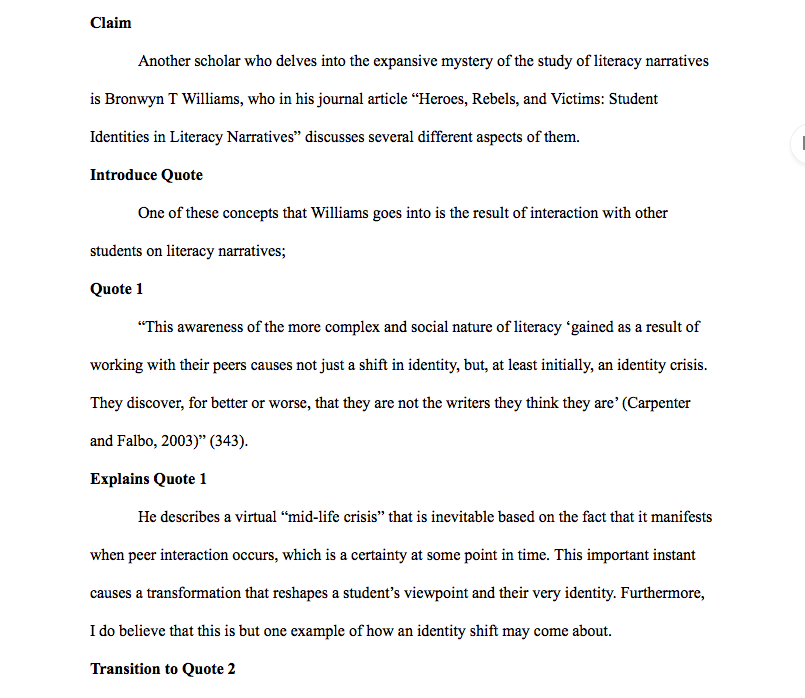**I did my worksheet on the computer**
Paragraph 1

Another scholar who delves into the expansive mystery of the study of literacy narratives is Bronwyn T Williams, who in his journal article “Heroes, Rebels, and Victims: Student Identities in Literacy Narratives” discusses several different aspects of them. One of these concepts that Williams goes into is the result of interaction with other students on literacy narratives; “This awareness of the more complex and social nature of literacy ‘gained as a result of working with their peers causes not just a shift in identity, but, at least initially, an identity crisis. They discover, for better or worse, that they are not the writers they think they are’ (Carpenter and Falbo, 2003)” (343). He describes a virtual “mid-life crisis” that is inevitable based on the fact that it manifests when peer interaction occurs, which is a certainty at some point in time. This important instant causes a transformation that reshapes a student’s viewpoint and their very identity. Furthermore, I do believe that this is but one example of how an identity shift may come about. In our English class each student individually read and annotated a number of peer written literacy narratives to use as evidence in or discussion of the acquisition of literacy. One of these narratives was written by Hannah Clark, entitled, “The Year I Started to Hate Writing”, depicting Hannah’s transition from a victim of her teacher’s inadequate teaching style to her own hero, pulling herself out of the academic hole she found herself in. She explains that her teacher, “[Mr Freitas,] usually went through the lessons and the notes so quickly that even the students who usually never struggled did struggle. So the students who normally did struggle had even more trouble succeeding in the class” (Clark). She was made into a victim by her instructor, and the performances of her peers. Later on in her story Hannah came to a decision; “Because I had given up hope that I would receive help from the teacher and began to struggle in class, I had to figure things out for myself” (Clark). She became her own hero, and resulting in the insufficient amount of aid she received, she took it upon herself to go to a tutoring center her high school offered, eventually leading to better grades. While her interaction with her other students, realizing she was just a number in a mass of people, was not the only factor driving her crisis, combining that with the interaction, or lack thereof, with her teacher, brought about her identity shift. Her struggle in English class was but a footnote in her academic career, but the moment she went from a victim identity to a hero identity, her story was created, adding depth and another dimension to an otherwise flat narrative. Interestingly, this noteworthy transformation was not created by herself, but rather the interaction with someone who sought to alter her literacy.
Paragraph 2

n Sponsors are an unavoidable aspect of literacy, as one cannot simply learn anything by themselves, but rather has to follow in the footsteps, whether directly or indirectly, of another. Later in Brandt’s article on sponsorship, she explains that “most of the time… literacy takes its shape from the interests of its sponsors. And… obligations toward one’s sponsors run deep, affecting what, why, and how people write and read” (168). Student’s heroes, teachers, and other influences bleed through into their expressions of literacy, correlating to the fact that these same people also create the meaningful turning points that result in an identity shift. In another example literacy narrative, “Turn Around”, written by Kayla Farrell, this sponsor influence is highlighted. In the opening line of her story she describes that she was “always a good little reader and writer in elementary school and middle school. I always loved to read with my parents when I was little” (Farrell), emphasizing the child prodigy identity. Later, after being taught by a Mr Stritch she explained that “everything I did in that class was never good enough, I always got negative feedback, red x’s, and bad grades in his class. It just seemed to slowly eat away at any confidence in writing that I had leftover” (Farrell), illuminating her transition into a victim identity. Lastly, years after her experience, Kayla realized that “getting constructive criticism from other students has just helped my writing in more ways than I can explain” (Farrell), completing her transformation into a success identity. Kayla’s identity was her own until she was introduced to a sponsor, albeit not a great one, Mr Strich, whose influence triggered an identity shift. Even years after her class spent with that teacher, his significance still remains in her mind, and Mr Strich’s negative criticism paved the way for Kayla’s high value of positive criticism. As we already know however, a sponsor does not necessarily have to have a bad effect on those they sponsor.
Annotations:
